NURS3017: An Analysis of Leadership in Healthcare and Patient Outcomes
VerifiedAdded on 2021/06/17
|12
|3215
|555
Essay
AI Summary
This essay explores the critical role of leadership in healthcare, examining how different leadership styles – transactional, transformational, and situational – influence nurse job satisfaction and patient health outcomes. It delves into essential nursing leadership qualities, emphasizing emotional intelligence, communication skills, and delegation. The essay highlights the significant impact of leadership on workplace culture, staff turnover, and the overall quality of care, underscoring the importance of accountability, clear communication, and supportive environments. The analysis demonstrates the strong correlation between effective leadership and positive patient outcomes, emphasizing the need for leaders to foster trust, compassion, and continuous improvement within healthcare settings. The essay concludes by reinforcing the importance of leadership in shaping a positive healthcare environment that prioritizes both patient well-being and nurse satisfaction.

RANJITA LAMA
SID- 460396897
Nurs 3017
SID- 460396897
Nurs 3017
Paraphrase This Document
Need a fresh take? Get an instant paraphrase of this document with our AI Paraphraser
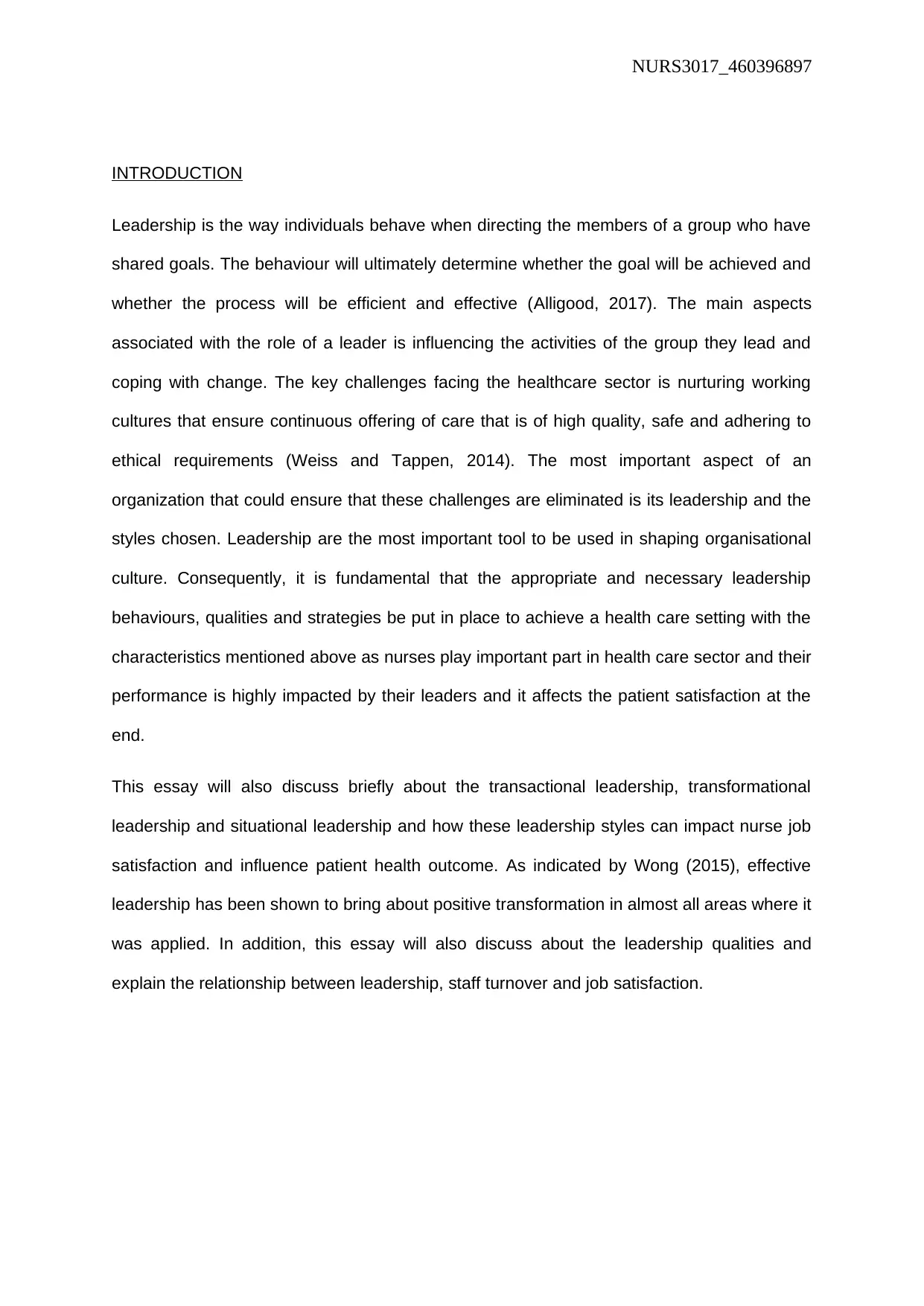
NURS3017_460396897
INTRODUCTION
Leadership is the way individuals behave when directing the members of a group who have
shared goals. The behaviour will ultimately determine whether the goal will be achieved and
whether the process will be efficient and effective (Alligood, 2017). The main aspects
associated with the role of a leader is influencing the activities of the group they lead and
coping with change. The key challenges facing the healthcare sector is nurturing working
cultures that ensure continuous offering of care that is of high quality, safe and adhering to
ethical requirements (Weiss and Tappen, 2014). The most important aspect of an
organization that could ensure that these challenges are eliminated is its leadership and the
styles chosen. Leadership are the most important tool to be used in shaping organisational
culture. Consequently, it is fundamental that the appropriate and necessary leadership
behaviours, qualities and strategies be put in place to achieve a health care setting with the
characteristics mentioned above as nurses play important part in health care sector and their
performance is highly impacted by their leaders and it affects the patient satisfaction at the
end.
This essay will also discuss briefly about the transactional leadership, transformational
leadership and situational leadership and how these leadership styles can impact nurse job
satisfaction and influence patient health outcome. As indicated by Wong (2015), effective
leadership has been shown to bring about positive transformation in almost all areas where it
was applied. In addition, this essay will also discuss about the leadership qualities and
explain the relationship between leadership, staff turnover and job satisfaction.
INTRODUCTION
Leadership is the way individuals behave when directing the members of a group who have
shared goals. The behaviour will ultimately determine whether the goal will be achieved and
whether the process will be efficient and effective (Alligood, 2017). The main aspects
associated with the role of a leader is influencing the activities of the group they lead and
coping with change. The key challenges facing the healthcare sector is nurturing working
cultures that ensure continuous offering of care that is of high quality, safe and adhering to
ethical requirements (Weiss and Tappen, 2014). The most important aspect of an
organization that could ensure that these challenges are eliminated is its leadership and the
styles chosen. Leadership are the most important tool to be used in shaping organisational
culture. Consequently, it is fundamental that the appropriate and necessary leadership
behaviours, qualities and strategies be put in place to achieve a health care setting with the
characteristics mentioned above as nurses play important part in health care sector and their
performance is highly impacted by their leaders and it affects the patient satisfaction at the
end.
This essay will also discuss briefly about the transactional leadership, transformational
leadership and situational leadership and how these leadership styles can impact nurse job
satisfaction and influence patient health outcome. As indicated by Wong (2015), effective
leadership has been shown to bring about positive transformation in almost all areas where it
was applied. In addition, this essay will also discuss about the leadership qualities and
explain the relationship between leadership, staff turnover and job satisfaction.
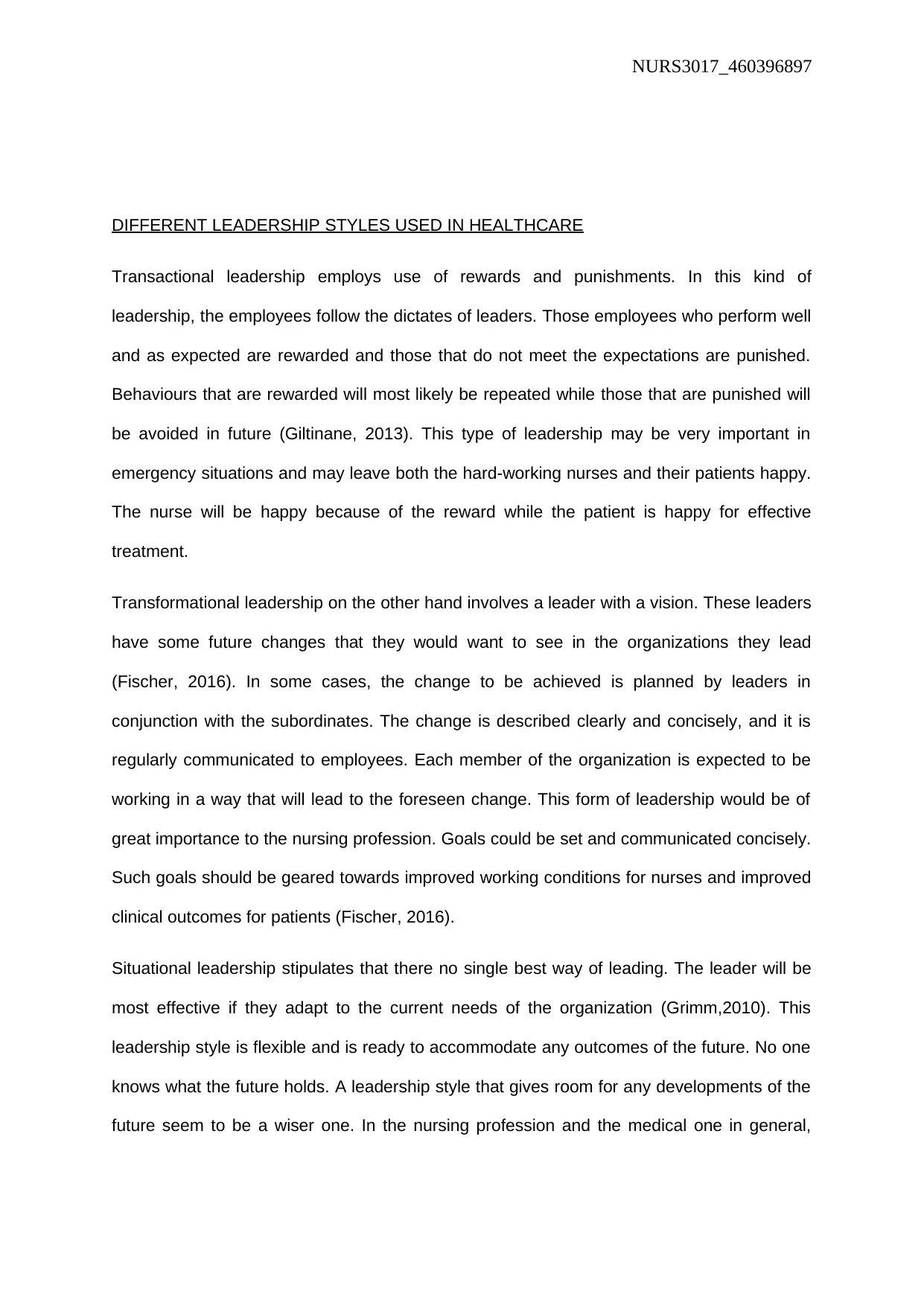
NURS3017_460396897
DIFFERENT LEADERSHIP STYLES USED IN HEALTHCARE
Transactional leadership employs use of rewards and punishments. In this kind of
leadership, the employees follow the dictates of leaders. Those employees who perform well
and as expected are rewarded and those that do not meet the expectations are punished.
Behaviours that are rewarded will most likely be repeated while those that are punished will
be avoided in future (Giltinane, 2013). This type of leadership may be very important in
emergency situations and may leave both the hard-working nurses and their patients happy.
The nurse will be happy because of the reward while the patient is happy for effective
treatment.
Transformational leadership on the other hand involves a leader with a vision. These leaders
have some future changes that they would want to see in the organizations they lead
(Fischer, 2016). In some cases, the change to be achieved is planned by leaders in
conjunction with the subordinates. The change is described clearly and concisely, and it is
regularly communicated to employees. Each member of the organization is expected to be
working in a way that will lead to the foreseen change. This form of leadership would be of
great importance to the nursing profession. Goals could be set and communicated concisely.
Such goals should be geared towards improved working conditions for nurses and improved
clinical outcomes for patients (Fischer, 2016).
Situational leadership stipulates that there no single best way of leading. The leader will be
most effective if they adapt to the current needs of the organization (Grimm,2010). This
leadership style is flexible and is ready to accommodate any outcomes of the future. No one
knows what the future holds. A leadership style that gives room for any developments of the
future seem to be a wiser one. In the nursing profession and the medical one in general,
DIFFERENT LEADERSHIP STYLES USED IN HEALTHCARE
Transactional leadership employs use of rewards and punishments. In this kind of
leadership, the employees follow the dictates of leaders. Those employees who perform well
and as expected are rewarded and those that do not meet the expectations are punished.
Behaviours that are rewarded will most likely be repeated while those that are punished will
be avoided in future (Giltinane, 2013). This type of leadership may be very important in
emergency situations and may leave both the hard-working nurses and their patients happy.
The nurse will be happy because of the reward while the patient is happy for effective
treatment.
Transformational leadership on the other hand involves a leader with a vision. These leaders
have some future changes that they would want to see in the organizations they lead
(Fischer, 2016). In some cases, the change to be achieved is planned by leaders in
conjunction with the subordinates. The change is described clearly and concisely, and it is
regularly communicated to employees. Each member of the organization is expected to be
working in a way that will lead to the foreseen change. This form of leadership would be of
great importance to the nursing profession. Goals could be set and communicated concisely.
Such goals should be geared towards improved working conditions for nurses and improved
clinical outcomes for patients (Fischer, 2016).
Situational leadership stipulates that there no single best way of leading. The leader will be
most effective if they adapt to the current needs of the organization (Grimm,2010). This
leadership style is flexible and is ready to accommodate any outcomes of the future. No one
knows what the future holds. A leadership style that gives room for any developments of the
future seem to be a wiser one. In the nursing profession and the medical one in general,
⊘ This is a preview!⊘
Do you want full access?
Subscribe today to unlock all pages.

Trusted by 1+ million students worldwide
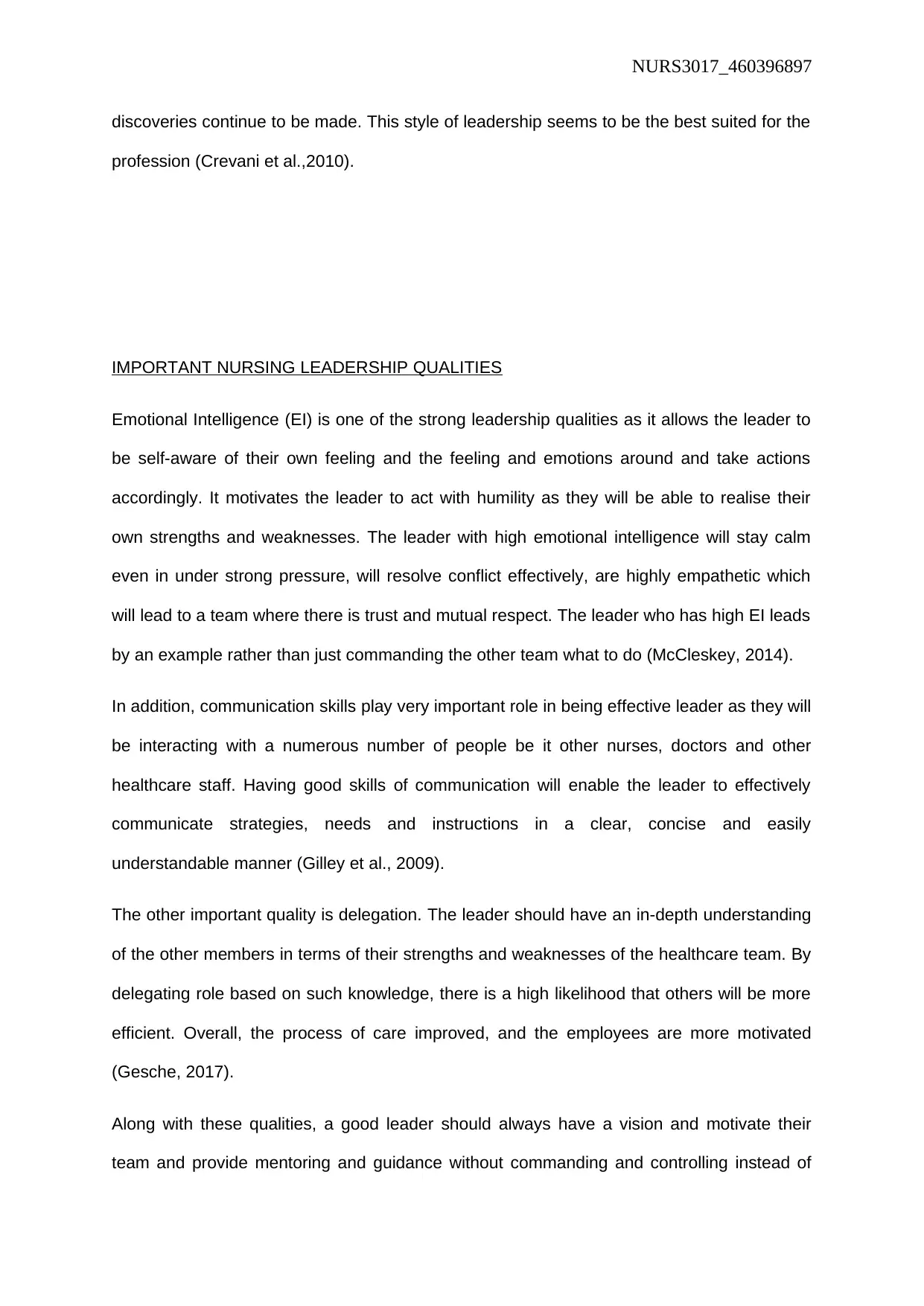
NURS3017_460396897
discoveries continue to be made. This style of leadership seems to be the best suited for the
profession (Crevani et al.,2010).
IMPORTANT NURSING LEADERSHIP QUALITIES
Emotional Intelligence (EI) is one of the strong leadership qualities as it allows the leader to
be self-aware of their own feeling and the feeling and emotions around and take actions
accordingly. It motivates the leader to act with humility as they will be able to realise their
own strengths and weaknesses. The leader with high emotional intelligence will stay calm
even in under strong pressure, will resolve conflict effectively, are highly empathetic which
will lead to a team where there is trust and mutual respect. The leader who has high EI leads
by an example rather than just commanding the other team what to do (McCleskey, 2014).
In addition, communication skills play very important role in being effective leader as they will
be interacting with a numerous number of people be it other nurses, doctors and other
healthcare staff. Having good skills of communication will enable the leader to effectively
communicate strategies, needs and instructions in a clear, concise and easily
understandable manner (Gilley et al., 2009).
The other important quality is delegation. The leader should have an in-depth understanding
of the other members in terms of their strengths and weaknesses of the healthcare team. By
delegating role based on such knowledge, there is a high likelihood that others will be more
efficient. Overall, the process of care improved, and the employees are more motivated
(Gesche, 2017).
Along with these qualities, a good leader should always have a vision and motivate their
team and provide mentoring and guidance without commanding and controlling instead of
discoveries continue to be made. This style of leadership seems to be the best suited for the
profession (Crevani et al.,2010).
IMPORTANT NURSING LEADERSHIP QUALITIES
Emotional Intelligence (EI) is one of the strong leadership qualities as it allows the leader to
be self-aware of their own feeling and the feeling and emotions around and take actions
accordingly. It motivates the leader to act with humility as they will be able to realise their
own strengths and weaknesses. The leader with high emotional intelligence will stay calm
even in under strong pressure, will resolve conflict effectively, are highly empathetic which
will lead to a team where there is trust and mutual respect. The leader who has high EI leads
by an example rather than just commanding the other team what to do (McCleskey, 2014).
In addition, communication skills play very important role in being effective leader as they will
be interacting with a numerous number of people be it other nurses, doctors and other
healthcare staff. Having good skills of communication will enable the leader to effectively
communicate strategies, needs and instructions in a clear, concise and easily
understandable manner (Gilley et al., 2009).
The other important quality is delegation. The leader should have an in-depth understanding
of the other members in terms of their strengths and weaknesses of the healthcare team. By
delegating role based on such knowledge, there is a high likelihood that others will be more
efficient. Overall, the process of care improved, and the employees are more motivated
(Gesche, 2017).
Along with these qualities, a good leader should always have a vision and motivate their
team and provide mentoring and guidance without commanding and controlling instead of
Paraphrase This Document
Need a fresh take? Get an instant paraphrase of this document with our AI Paraphraser
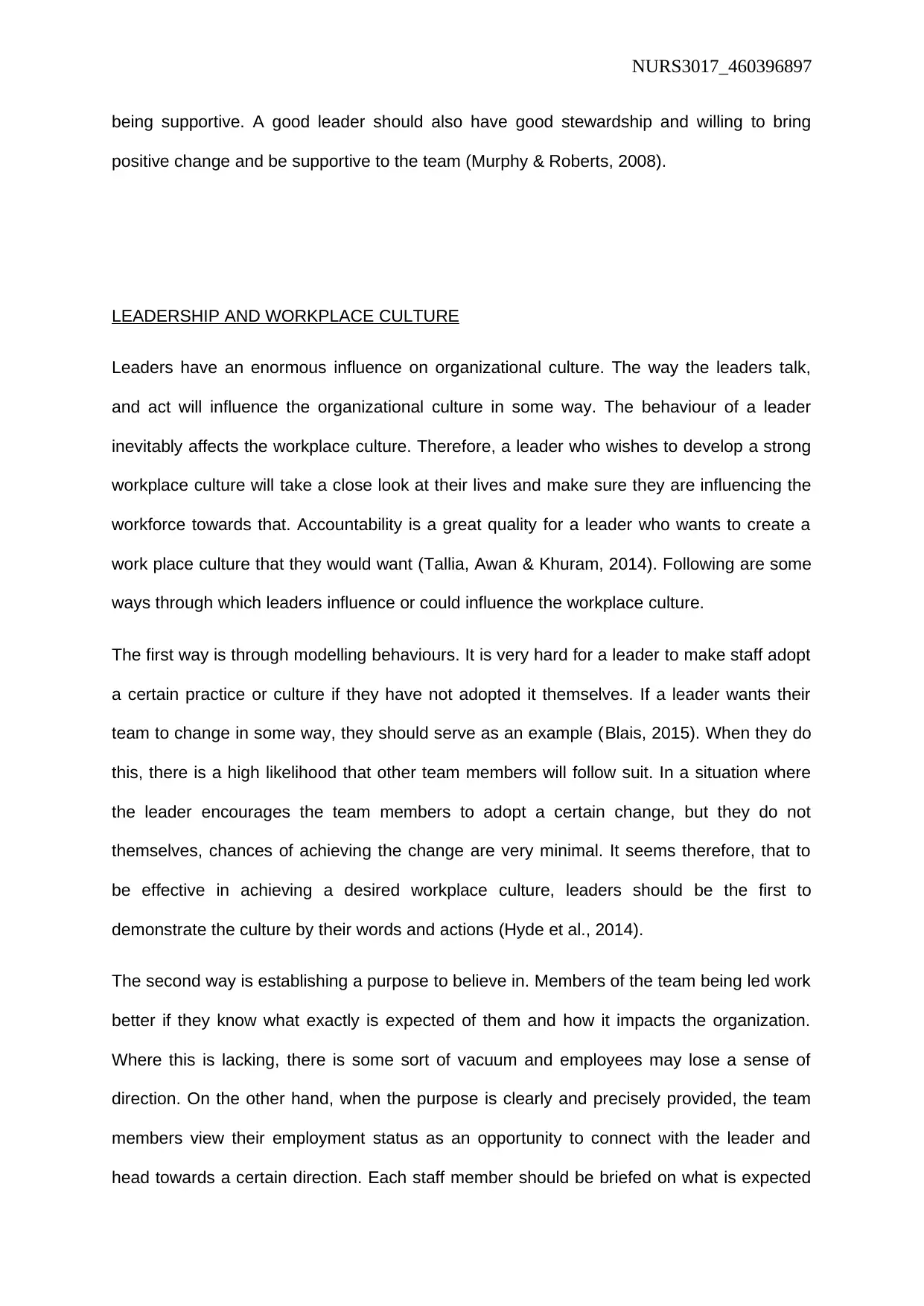
NURS3017_460396897
being supportive. A good leader should also have good stewardship and willing to bring
positive change and be supportive to the team (Murphy & Roberts, 2008).
LEADERSHIP AND WORKPLACE CULTURE
Leaders have an enormous influence on organizational culture. The way the leaders talk,
and act will influence the organizational culture in some way. The behaviour of a leader
inevitably affects the workplace culture. Therefore, a leader who wishes to develop a strong
workplace culture will take a close look at their lives and make sure they are influencing the
workforce towards that. Accountability is a great quality for a leader who wants to create a
work place culture that they would want (Tallia, Awan & Khuram, 2014). Following are some
ways through which leaders influence or could influence the workplace culture.
The first way is through modelling behaviours. It is very hard for a leader to make staff adopt
a certain practice or culture if they have not adopted it themselves. If a leader wants their
team to change in some way, they should serve as an example (Blais, 2015). When they do
this, there is a high likelihood that other team members will follow suit. In a situation where
the leader encourages the team members to adopt a certain change, but they do not
themselves, chances of achieving the change are very minimal. It seems therefore, that to
be effective in achieving a desired workplace culture, leaders should be the first to
demonstrate the culture by their words and actions (Hyde et al., 2014).
The second way is establishing a purpose to believe in. Members of the team being led work
better if they know what exactly is expected of them and how it impacts the organization.
Where this is lacking, there is some sort of vacuum and employees may lose a sense of
direction. On the other hand, when the purpose is clearly and precisely provided, the team
members view their employment status as an opportunity to connect with the leader and
head towards a certain direction. Each staff member should be briefed on what is expected
being supportive. A good leader should also have good stewardship and willing to bring
positive change and be supportive to the team (Murphy & Roberts, 2008).
LEADERSHIP AND WORKPLACE CULTURE
Leaders have an enormous influence on organizational culture. The way the leaders talk,
and act will influence the organizational culture in some way. The behaviour of a leader
inevitably affects the workplace culture. Therefore, a leader who wishes to develop a strong
workplace culture will take a close look at their lives and make sure they are influencing the
workforce towards that. Accountability is a great quality for a leader who wants to create a
work place culture that they would want (Tallia, Awan & Khuram, 2014). Following are some
ways through which leaders influence or could influence the workplace culture.
The first way is through modelling behaviours. It is very hard for a leader to make staff adopt
a certain practice or culture if they have not adopted it themselves. If a leader wants their
team to change in some way, they should serve as an example (Blais, 2015). When they do
this, there is a high likelihood that other team members will follow suit. In a situation where
the leader encourages the team members to adopt a certain change, but they do not
themselves, chances of achieving the change are very minimal. It seems therefore, that to
be effective in achieving a desired workplace culture, leaders should be the first to
demonstrate the culture by their words and actions (Hyde et al., 2014).
The second way is establishing a purpose to believe in. Members of the team being led work
better if they know what exactly is expected of them and how it impacts the organization.
Where this is lacking, there is some sort of vacuum and employees may lose a sense of
direction. On the other hand, when the purpose is clearly and precisely provided, the team
members view their employment status as an opportunity to connect with the leader and
head towards a certain direction. Each staff member should be briefed on what is expected
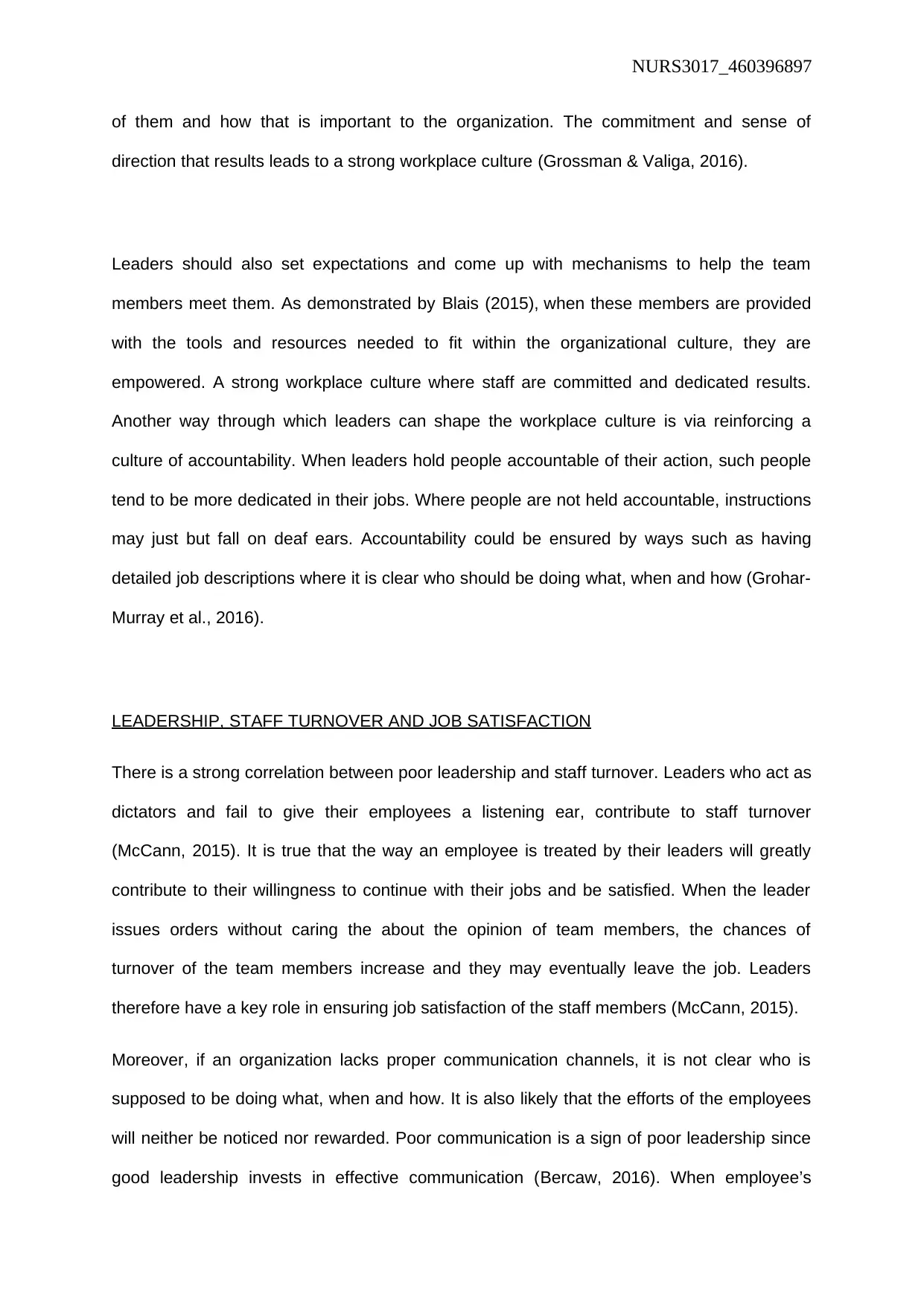
NURS3017_460396897
of them and how that is important to the organization. The commitment and sense of
direction that results leads to a strong workplace culture (Grossman & Valiga, 2016).
Leaders should also set expectations and come up with mechanisms to help the team
members meet them. As demonstrated by Blais (2015), when these members are provided
with the tools and resources needed to fit within the organizational culture, they are
empowered. A strong workplace culture where staff are committed and dedicated results.
Another way through which leaders can shape the workplace culture is via reinforcing a
culture of accountability. When leaders hold people accountable of their action, such people
tend to be more dedicated in their jobs. Where people are not held accountable, instructions
may just but fall on deaf ears. Accountability could be ensured by ways such as having
detailed job descriptions where it is clear who should be doing what, when and how (Grohar-
Murray et al., 2016).
LEADERSHIP, STAFF TURNOVER AND JOB SATISFACTION
There is a strong correlation between poor leadership and staff turnover. Leaders who act as
dictators and fail to give their employees a listening ear, contribute to staff turnover
(McCann, 2015). It is true that the way an employee is treated by their leaders will greatly
contribute to their willingness to continue with their jobs and be satisfied. When the leader
issues orders without caring the about the opinion of team members, the chances of
turnover of the team members increase and they may eventually leave the job. Leaders
therefore have a key role in ensuring job satisfaction of the staff members (McCann, 2015).
Moreover, if an organization lacks proper communication channels, it is not clear who is
supposed to be doing what, when and how. It is also likely that the efforts of the employees
will neither be noticed nor rewarded. Poor communication is a sign of poor leadership since
good leadership invests in effective communication (Bercaw, 2016). When employee’s
of them and how that is important to the organization. The commitment and sense of
direction that results leads to a strong workplace culture (Grossman & Valiga, 2016).
Leaders should also set expectations and come up with mechanisms to help the team
members meet them. As demonstrated by Blais (2015), when these members are provided
with the tools and resources needed to fit within the organizational culture, they are
empowered. A strong workplace culture where staff are committed and dedicated results.
Another way through which leaders can shape the workplace culture is via reinforcing a
culture of accountability. When leaders hold people accountable of their action, such people
tend to be more dedicated in their jobs. Where people are not held accountable, instructions
may just but fall on deaf ears. Accountability could be ensured by ways such as having
detailed job descriptions where it is clear who should be doing what, when and how (Grohar-
Murray et al., 2016).
LEADERSHIP, STAFF TURNOVER AND JOB SATISFACTION
There is a strong correlation between poor leadership and staff turnover. Leaders who act as
dictators and fail to give their employees a listening ear, contribute to staff turnover
(McCann, 2015). It is true that the way an employee is treated by their leaders will greatly
contribute to their willingness to continue with their jobs and be satisfied. When the leader
issues orders without caring the about the opinion of team members, the chances of
turnover of the team members increase and they may eventually leave the job. Leaders
therefore have a key role in ensuring job satisfaction of the staff members (McCann, 2015).
Moreover, if an organization lacks proper communication channels, it is not clear who is
supposed to be doing what, when and how. It is also likely that the efforts of the employees
will neither be noticed nor rewarded. Poor communication is a sign of poor leadership since
good leadership invests in effective communication (Bercaw, 2016). When employee’s
⊘ This is a preview!⊘
Do you want full access?
Subscribe today to unlock all pages.

Trusted by 1+ million students worldwide
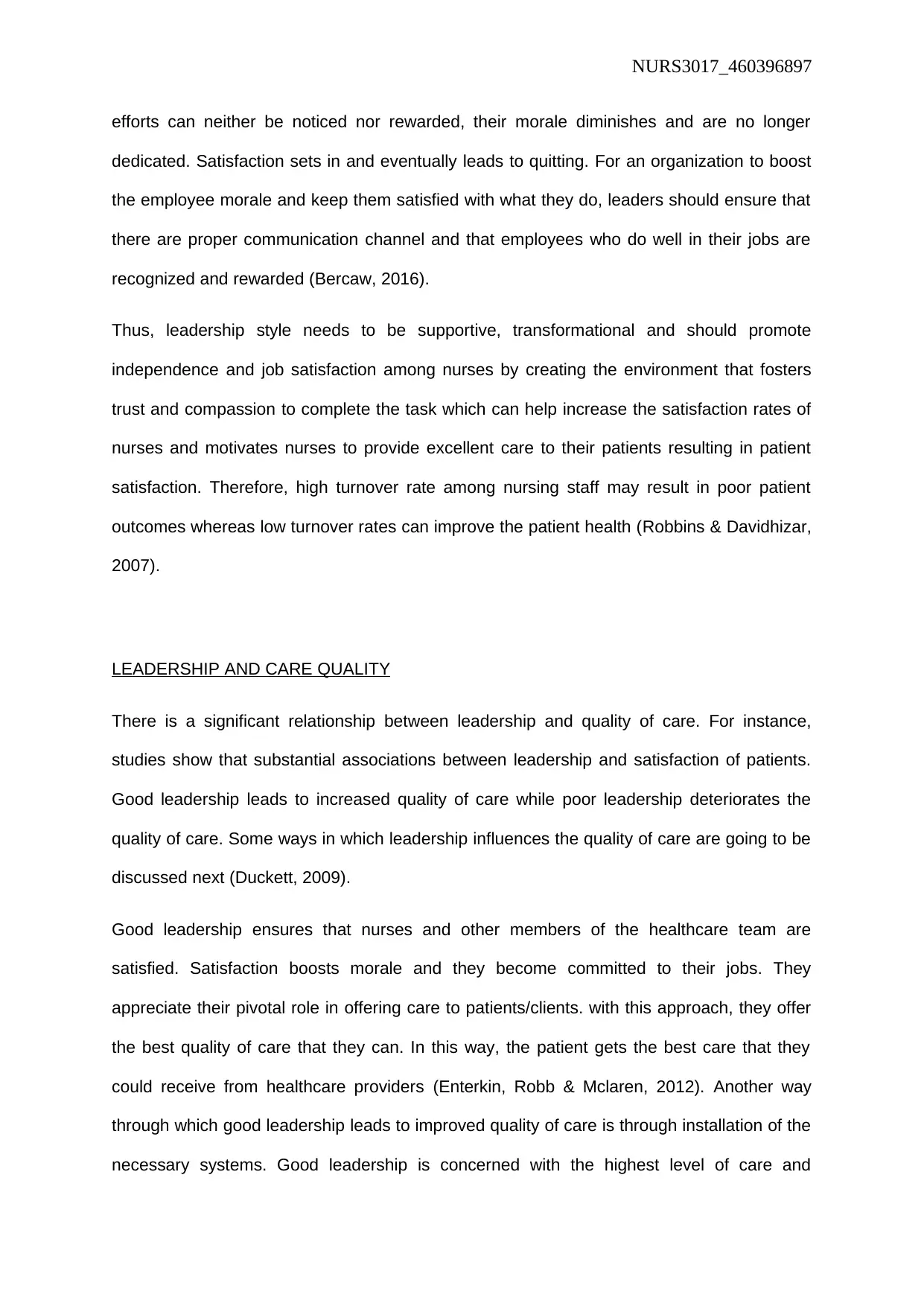
NURS3017_460396897
efforts can neither be noticed nor rewarded, their morale diminishes and are no longer
dedicated. Satisfaction sets in and eventually leads to quitting. For an organization to boost
the employee morale and keep them satisfied with what they do, leaders should ensure that
there are proper communication channel and that employees who do well in their jobs are
recognized and rewarded (Bercaw, 2016).
Thus, leadership style needs to be supportive, transformational and should promote
independence and job satisfaction among nurses by creating the environment that fosters
trust and compassion to complete the task which can help increase the satisfaction rates of
nurses and motivates nurses to provide excellent care to their patients resulting in patient
satisfaction. Therefore, high turnover rate among nursing staff may result in poor patient
outcomes whereas low turnover rates can improve the patient health (Robbins & Davidhizar,
2007).
LEADERSHIP AND CARE QUALITY
There is a significant relationship between leadership and quality of care. For instance,
studies show that substantial associations between leadership and satisfaction of patients.
Good leadership leads to increased quality of care while poor leadership deteriorates the
quality of care. Some ways in which leadership influences the quality of care are going to be
discussed next (Duckett, 2009).
Good leadership ensures that nurses and other members of the healthcare team are
satisfied. Satisfaction boosts morale and they become committed to their jobs. They
appreciate their pivotal role in offering care to patients/clients. with this approach, they offer
the best quality of care that they can. In this way, the patient gets the best care that they
could receive from healthcare providers (Enterkin, Robb & Mclaren, 2012). Another way
through which good leadership leads to improved quality of care is through installation of the
necessary systems. Good leadership is concerned with the highest level of care and
efforts can neither be noticed nor rewarded, their morale diminishes and are no longer
dedicated. Satisfaction sets in and eventually leads to quitting. For an organization to boost
the employee morale and keep them satisfied with what they do, leaders should ensure that
there are proper communication channel and that employees who do well in their jobs are
recognized and rewarded (Bercaw, 2016).
Thus, leadership style needs to be supportive, transformational and should promote
independence and job satisfaction among nurses by creating the environment that fosters
trust and compassion to complete the task which can help increase the satisfaction rates of
nurses and motivates nurses to provide excellent care to their patients resulting in patient
satisfaction. Therefore, high turnover rate among nursing staff may result in poor patient
outcomes whereas low turnover rates can improve the patient health (Robbins & Davidhizar,
2007).
LEADERSHIP AND CARE QUALITY
There is a significant relationship between leadership and quality of care. For instance,
studies show that substantial associations between leadership and satisfaction of patients.
Good leadership leads to increased quality of care while poor leadership deteriorates the
quality of care. Some ways in which leadership influences the quality of care are going to be
discussed next (Duckett, 2009).
Good leadership ensures that nurses and other members of the healthcare team are
satisfied. Satisfaction boosts morale and they become committed to their jobs. They
appreciate their pivotal role in offering care to patients/clients. with this approach, they offer
the best quality of care that they can. In this way, the patient gets the best care that they
could receive from healthcare providers (Enterkin, Robb & Mclaren, 2012). Another way
through which good leadership leads to improved quality of care is through installation of the
necessary systems. Good leadership is concerned with the highest level of care and
Paraphrase This Document
Need a fresh take? Get an instant paraphrase of this document with our AI Paraphraser
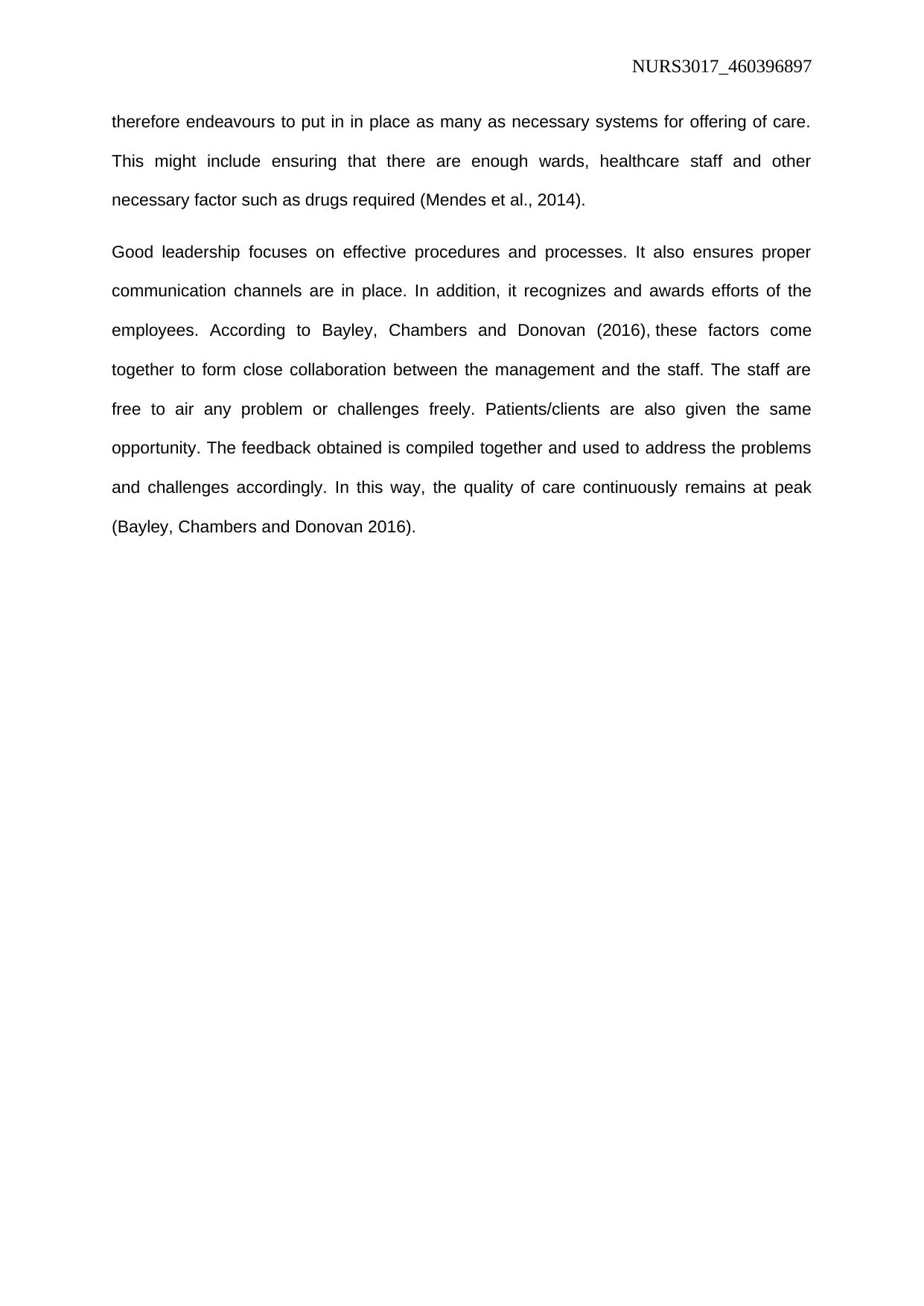
NURS3017_460396897
therefore endeavours to put in in place as many as necessary systems for offering of care.
This might include ensuring that there are enough wards, healthcare staff and other
necessary factor such as drugs required (Mendes et al., 2014).
Good leadership focuses on effective procedures and processes. It also ensures proper
communication channels are in place. In addition, it recognizes and awards efforts of the
employees. According to Bayley, Chambers and Donovan (2016), these factors come
together to form close collaboration between the management and the staff. The staff are
free to air any problem or challenges freely. Patients/clients are also given the same
opportunity. The feedback obtained is compiled together and used to address the problems
and challenges accordingly. In this way, the quality of care continuously remains at peak
(Bayley, Chambers and Donovan 2016).
therefore endeavours to put in in place as many as necessary systems for offering of care.
This might include ensuring that there are enough wards, healthcare staff and other
necessary factor such as drugs required (Mendes et al., 2014).
Good leadership focuses on effective procedures and processes. It also ensures proper
communication channels are in place. In addition, it recognizes and awards efforts of the
employees. According to Bayley, Chambers and Donovan (2016), these factors come
together to form close collaboration between the management and the staff. The staff are
free to air any problem or challenges freely. Patients/clients are also given the same
opportunity. The feedback obtained is compiled together and used to address the problems
and challenges accordingly. In this way, the quality of care continuously remains at peak
(Bayley, Chambers and Donovan 2016).
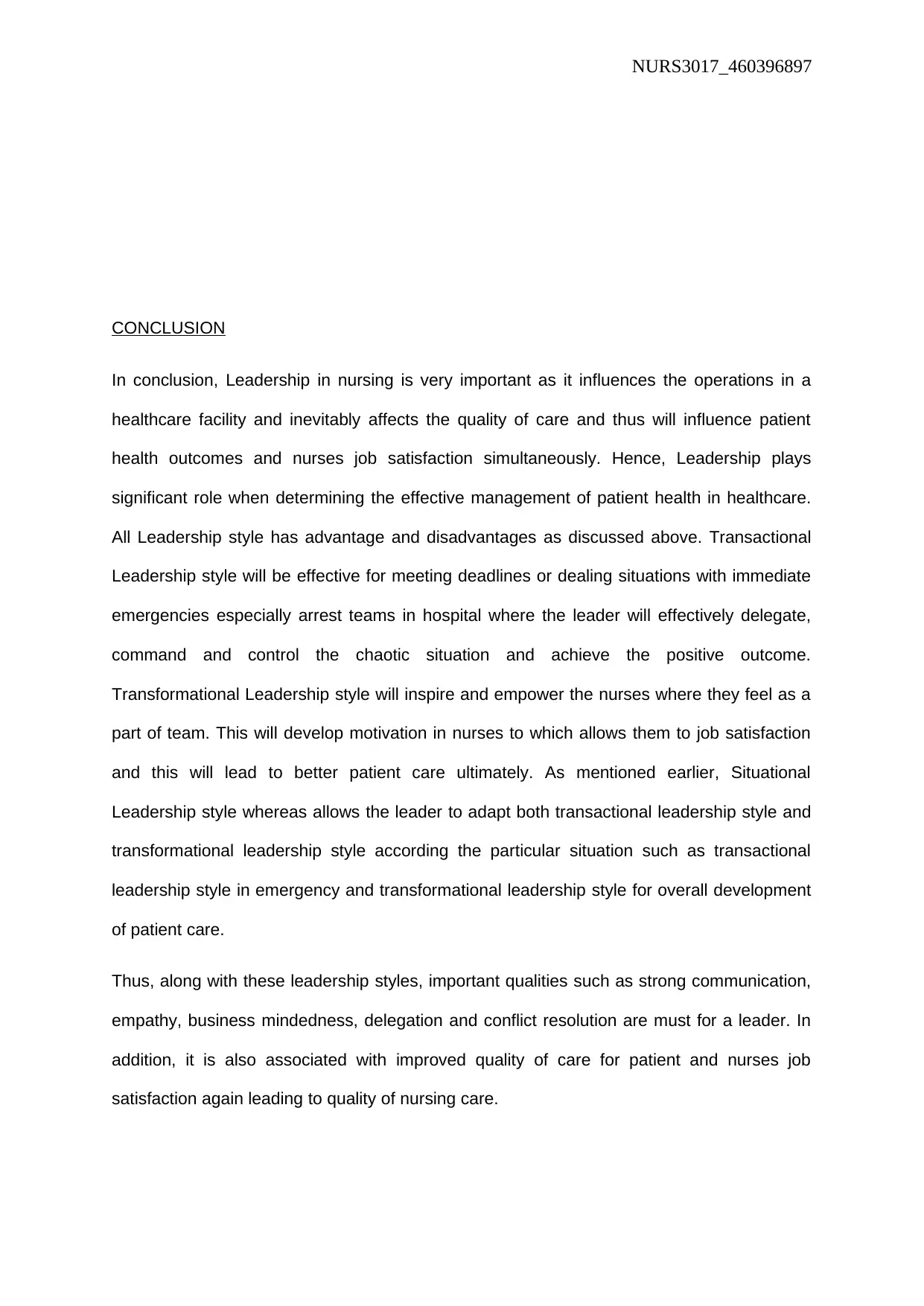
NURS3017_460396897
CONCLUSION
In conclusion, Leadership in nursing is very important as it influences the operations in a
healthcare facility and inevitably affects the quality of care and thus will influence patient
health outcomes and nurses job satisfaction simultaneously. Hence, Leadership plays
significant role when determining the effective management of patient health in healthcare.
All Leadership style has advantage and disadvantages as discussed above. Transactional
Leadership style will be effective for meeting deadlines or dealing situations with immediate
emergencies especially arrest teams in hospital where the leader will effectively delegate,
command and control the chaotic situation and achieve the positive outcome.
Transformational Leadership style will inspire and empower the nurses where they feel as a
part of team. This will develop motivation in nurses to which allows them to job satisfaction
and this will lead to better patient care ultimately. As mentioned earlier, Situational
Leadership style whereas allows the leader to adapt both transactional leadership style and
transformational leadership style according the particular situation such as transactional
leadership style in emergency and transformational leadership style for overall development
of patient care.
Thus, along with these leadership styles, important qualities such as strong communication,
empathy, business mindedness, delegation and conflict resolution are must for a leader. In
addition, it is also associated with improved quality of care for patient and nurses job
satisfaction again leading to quality of nursing care.
CONCLUSION
In conclusion, Leadership in nursing is very important as it influences the operations in a
healthcare facility and inevitably affects the quality of care and thus will influence patient
health outcomes and nurses job satisfaction simultaneously. Hence, Leadership plays
significant role when determining the effective management of patient health in healthcare.
All Leadership style has advantage and disadvantages as discussed above. Transactional
Leadership style will be effective for meeting deadlines or dealing situations with immediate
emergencies especially arrest teams in hospital where the leader will effectively delegate,
command and control the chaotic situation and achieve the positive outcome.
Transformational Leadership style will inspire and empower the nurses where they feel as a
part of team. This will develop motivation in nurses to which allows them to job satisfaction
and this will lead to better patient care ultimately. As mentioned earlier, Situational
Leadership style whereas allows the leader to adapt both transactional leadership style and
transformational leadership style according the particular situation such as transactional
leadership style in emergency and transformational leadership style for overall development
of patient care.
Thus, along with these leadership styles, important qualities such as strong communication,
empathy, business mindedness, delegation and conflict resolution are must for a leader. In
addition, it is also associated with improved quality of care for patient and nurses job
satisfaction again leading to quality of nursing care.
⊘ This is a preview!⊘
Do you want full access?
Subscribe today to unlock all pages.

Trusted by 1+ million students worldwide
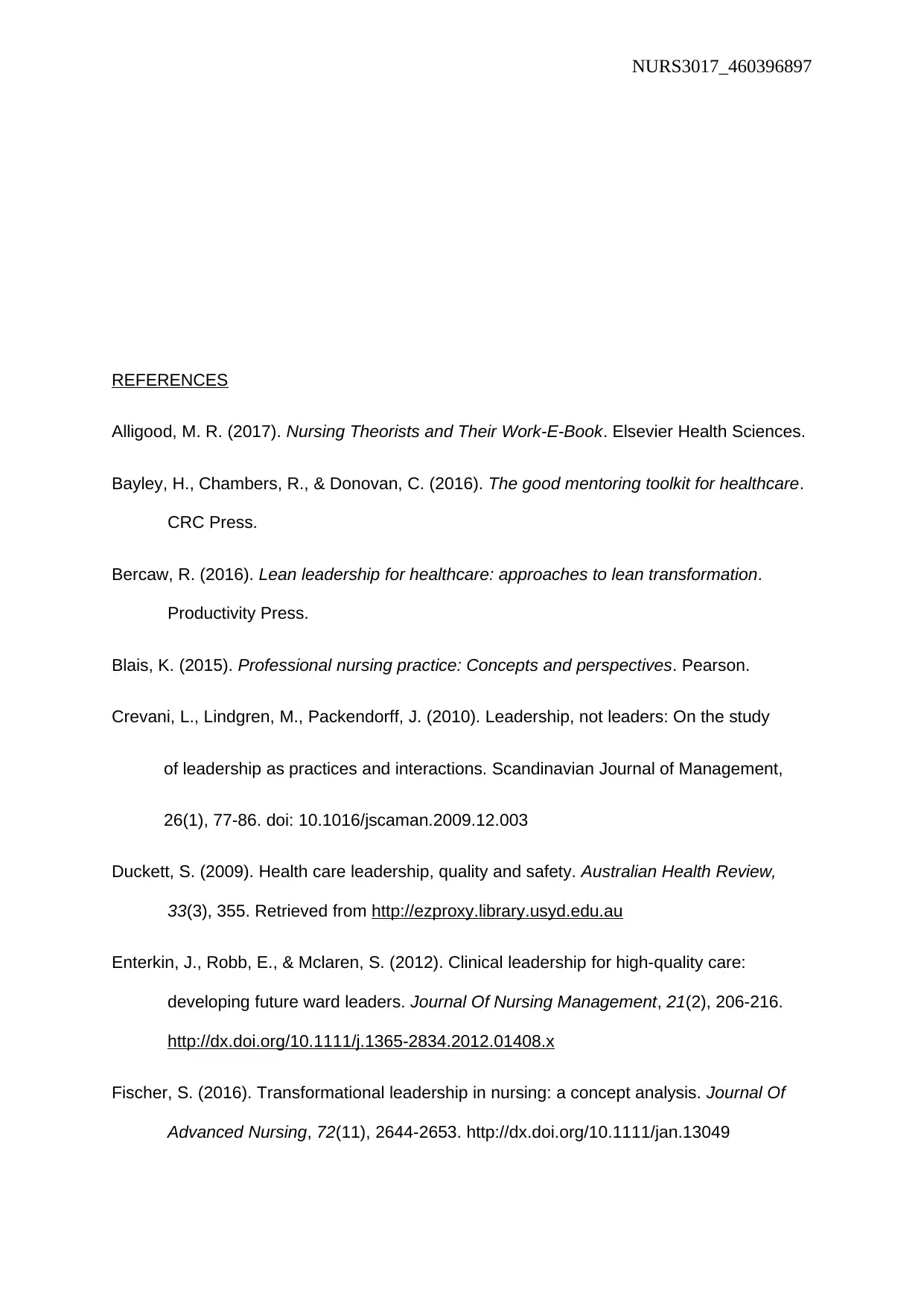
NURS3017_460396897
REFERENCES
Alligood, M. R. (2017). Nursing Theorists and Their Work-E-Book. Elsevier Health Sciences.
Bayley, H., Chambers, R., & Donovan, C. (2016). The good mentoring toolkit for healthcare.
CRC Press.
Bercaw, R. (2016). Lean leadership for healthcare: approaches to lean transformation.
Productivity Press.
Blais, K. (2015). Professional nursing practice: Concepts and perspectives. Pearson.
Crevani, L., Lindgren, M., Packendorff, J. (2010). Leadership, not leaders: On the study
of leadership as practices and interactions. Scandinavian Journal of Management,
26(1), 77-86. doi: 10.1016/jscaman.2009.12.003
Duckett, S. (2009). Health care leadership, quality and safety. Australian Health Review,
33(3), 355. Retrieved from http://ezproxy.library.usyd.edu.au
Enterkin, J., Robb, E., & Mclaren, S. (2012). Clinical leadership for high-quality care:
developing future ward leaders. Journal Of Nursing Management, 21(2), 206-216.
http://dx.doi.org/10.1111/j.1365-2834.2012.01408.x
Fischer, S. (2016). Transformational leadership in nursing: a concept analysis. Journal Of
Advanced Nursing, 72(11), 2644-2653. http://dx.doi.org/10.1111/jan.13049
REFERENCES
Alligood, M. R. (2017). Nursing Theorists and Their Work-E-Book. Elsevier Health Sciences.
Bayley, H., Chambers, R., & Donovan, C. (2016). The good mentoring toolkit for healthcare.
CRC Press.
Bercaw, R. (2016). Lean leadership for healthcare: approaches to lean transformation.
Productivity Press.
Blais, K. (2015). Professional nursing practice: Concepts and perspectives. Pearson.
Crevani, L., Lindgren, M., Packendorff, J. (2010). Leadership, not leaders: On the study
of leadership as practices and interactions. Scandinavian Journal of Management,
26(1), 77-86. doi: 10.1016/jscaman.2009.12.003
Duckett, S. (2009). Health care leadership, quality and safety. Australian Health Review,
33(3), 355. Retrieved from http://ezproxy.library.usyd.edu.au
Enterkin, J., Robb, E., & Mclaren, S. (2012). Clinical leadership for high-quality care:
developing future ward leaders. Journal Of Nursing Management, 21(2), 206-216.
http://dx.doi.org/10.1111/j.1365-2834.2012.01408.x
Fischer, S. (2016). Transformational leadership in nursing: a concept analysis. Journal Of
Advanced Nursing, 72(11), 2644-2653. http://dx.doi.org/10.1111/jan.13049
Paraphrase This Document
Need a fresh take? Get an instant paraphrase of this document with our AI Paraphraser
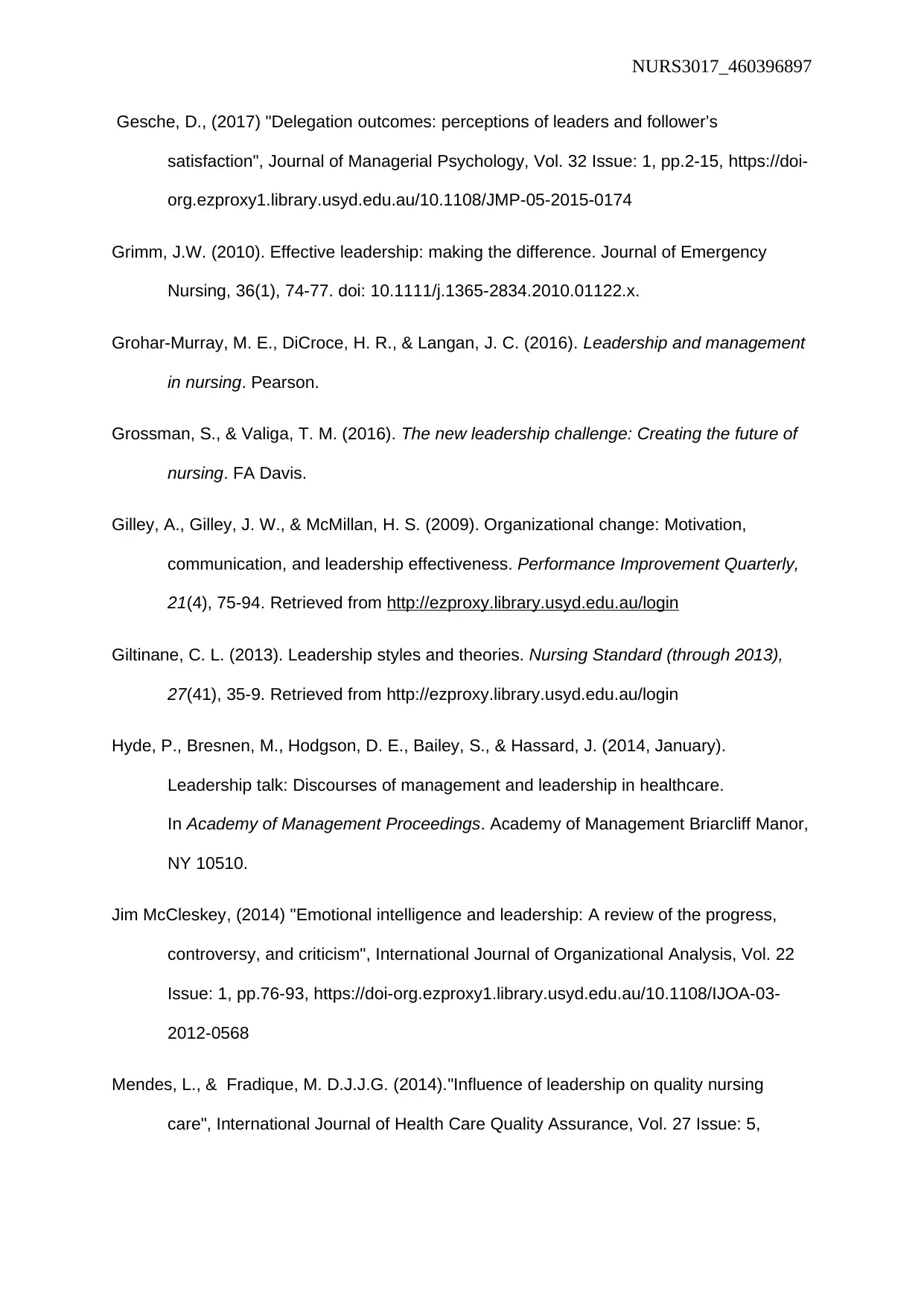
NURS3017_460396897
Gesche, D., (2017) "Delegation outcomes: perceptions of leaders and follower’s
satisfaction", Journal of Managerial Psychology, Vol. 32 Issue: 1, pp.2-15, https://doi-
org.ezproxy1.library.usyd.edu.au/10.1108/JMP-05-2015-0174
Grimm, J.W. (2010). Effective leadership: making the difference. Journal of Emergency
Nursing, 36(1), 74-77. doi: 10.1111/j.1365-2834.2010.01122.x.
Grohar-Murray, M. E., DiCroce, H. R., & Langan, J. C. (2016). Leadership and management
in nursing. Pearson.
Grossman, S., & Valiga, T. M. (2016). The new leadership challenge: Creating the future of
nursing. FA Davis.
Gilley, A., Gilley, J. W., & McMillan, H. S. (2009). Organizational change: Motivation,
communication, and leadership effectiveness. Performance Improvement Quarterly,
21(4), 75-94. Retrieved from http://ezproxy.library.usyd.edu.au/login
Giltinane, C. L. (2013). Leadership styles and theories. Nursing Standard (through 2013),
27(41), 35-9. Retrieved from http://ezproxy.library.usyd.edu.au/login
Hyde, P., Bresnen, M., Hodgson, D. E., Bailey, S., & Hassard, J. (2014, January).
Leadership talk: Discourses of management and leadership in healthcare.
In Academy of Management Proceedings. Academy of Management Briarcliff Manor,
NY 10510.
Jim McCleskey, (2014) "Emotional intelligence and leadership: A review of the progress,
controversy, and criticism", International Journal of Organizational Analysis, Vol. 22
Issue: 1, pp.76-93, https://doi-org.ezproxy1.library.usyd.edu.au/10.1108/IJOA-03-
2012-0568
Mendes, L., & Fradique, M. D.J.J.G. (2014)."Influence of leadership on quality nursing
care", International Journal of Health Care Quality Assurance, Vol. 27 Issue: 5,
Gesche, D., (2017) "Delegation outcomes: perceptions of leaders and follower’s
satisfaction", Journal of Managerial Psychology, Vol. 32 Issue: 1, pp.2-15, https://doi-
org.ezproxy1.library.usyd.edu.au/10.1108/JMP-05-2015-0174
Grimm, J.W. (2010). Effective leadership: making the difference. Journal of Emergency
Nursing, 36(1), 74-77. doi: 10.1111/j.1365-2834.2010.01122.x.
Grohar-Murray, M. E., DiCroce, H. R., & Langan, J. C. (2016). Leadership and management
in nursing. Pearson.
Grossman, S., & Valiga, T. M. (2016). The new leadership challenge: Creating the future of
nursing. FA Davis.
Gilley, A., Gilley, J. W., & McMillan, H. S. (2009). Organizational change: Motivation,
communication, and leadership effectiveness. Performance Improvement Quarterly,
21(4), 75-94. Retrieved from http://ezproxy.library.usyd.edu.au/login
Giltinane, C. L. (2013). Leadership styles and theories. Nursing Standard (through 2013),
27(41), 35-9. Retrieved from http://ezproxy.library.usyd.edu.au/login
Hyde, P., Bresnen, M., Hodgson, D. E., Bailey, S., & Hassard, J. (2014, January).
Leadership talk: Discourses of management and leadership in healthcare.
In Academy of Management Proceedings. Academy of Management Briarcliff Manor,
NY 10510.
Jim McCleskey, (2014) "Emotional intelligence and leadership: A review of the progress,
controversy, and criticism", International Journal of Organizational Analysis, Vol. 22
Issue: 1, pp.76-93, https://doi-org.ezproxy1.library.usyd.edu.au/10.1108/IJOA-03-
2012-0568
Mendes, L., & Fradique, M. D.J.J.G. (2014)."Influence of leadership on quality nursing
care", International Journal of Health Care Quality Assurance, Vol. 27 Issue: 5,
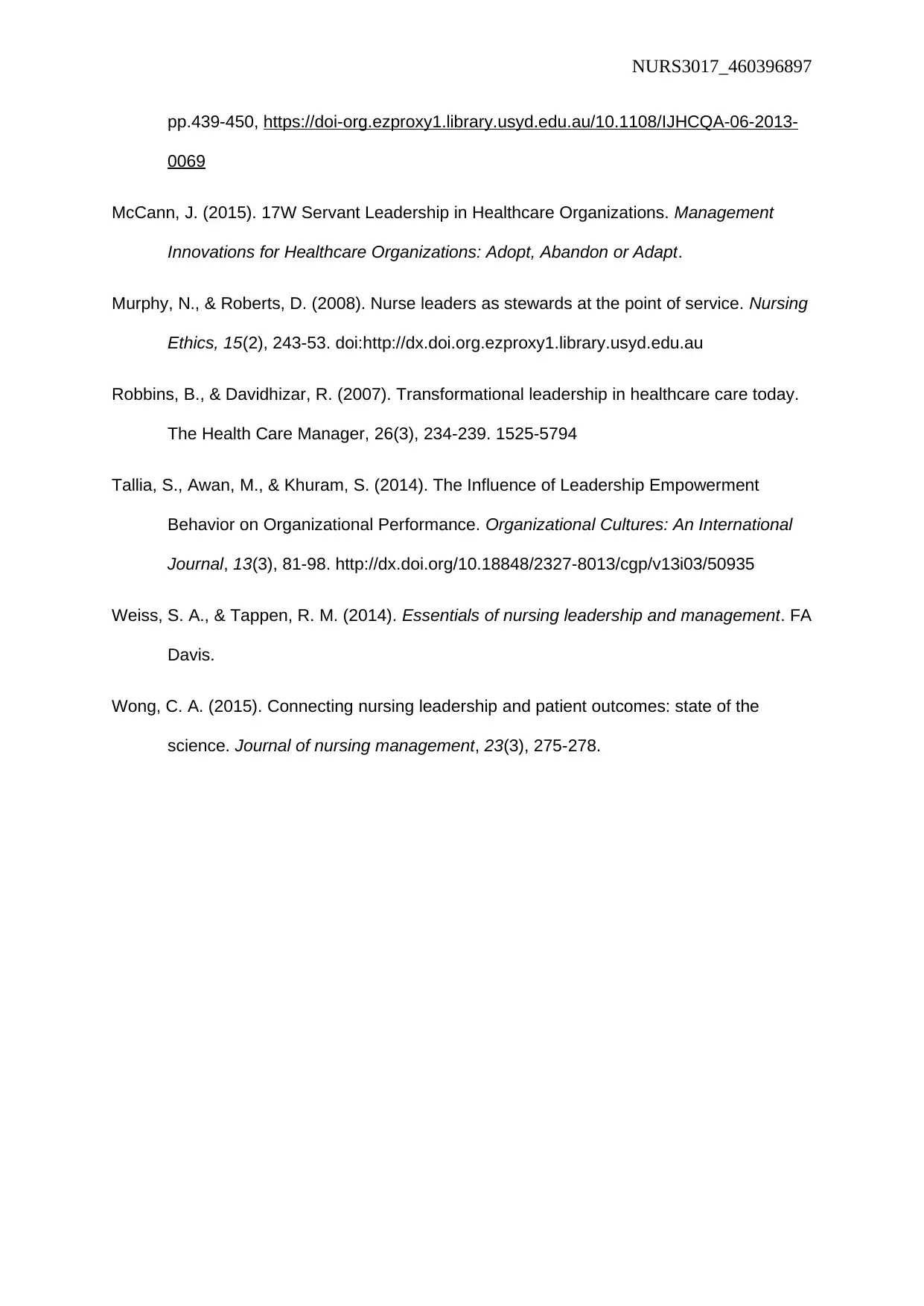
NURS3017_460396897
pp.439-450, https://doi-org.ezproxy1.library.usyd.edu.au/10.1108/IJHCQA-06-2013-
0069
McCann, J. (2015). 17W Servant Leadership in Healthcare Organizations. Management
Innovations for Healthcare Organizations: Adopt, Abandon or Adapt.
Murphy, N., & Roberts, D. (2008). Nurse leaders as stewards at the point of service. Nursing
Ethics, 15(2), 243-53. doi:http://dx.doi.org.ezproxy1.library.usyd.edu.au
Robbins, B., & Davidhizar, R. (2007). Transformational leadership in healthcare care today.
The Health Care Manager, 26(3), 234-239. 1525-5794
Tallia, S., Awan, M., & Khuram, S. (2014). The Influence of Leadership Empowerment
Behavior on Organizational Performance. Organizational Cultures: An International
Journal, 13(3), 81-98. http://dx.doi.org/10.18848/2327-8013/cgp/v13i03/50935
Weiss, S. A., & Tappen, R. M. (2014). Essentials of nursing leadership and management. FA
Davis.
Wong, C. A. (2015). Connecting nursing leadership and patient outcomes: state of the
science. Journal of nursing management, 23(3), 275-278.
pp.439-450, https://doi-org.ezproxy1.library.usyd.edu.au/10.1108/IJHCQA-06-2013-
0069
McCann, J. (2015). 17W Servant Leadership in Healthcare Organizations. Management
Innovations for Healthcare Organizations: Adopt, Abandon or Adapt.
Murphy, N., & Roberts, D. (2008). Nurse leaders as stewards at the point of service. Nursing
Ethics, 15(2), 243-53. doi:http://dx.doi.org.ezproxy1.library.usyd.edu.au
Robbins, B., & Davidhizar, R. (2007). Transformational leadership in healthcare care today.
The Health Care Manager, 26(3), 234-239. 1525-5794
Tallia, S., Awan, M., & Khuram, S. (2014). The Influence of Leadership Empowerment
Behavior on Organizational Performance. Organizational Cultures: An International
Journal, 13(3), 81-98. http://dx.doi.org/10.18848/2327-8013/cgp/v13i03/50935
Weiss, S. A., & Tappen, R. M. (2014). Essentials of nursing leadership and management. FA
Davis.
Wong, C. A. (2015). Connecting nursing leadership and patient outcomes: state of the
science. Journal of nursing management, 23(3), 275-278.
⊘ This is a preview!⊘
Do you want full access?
Subscribe today to unlock all pages.

Trusted by 1+ million students worldwide
1 out of 12
Related Documents
Your All-in-One AI-Powered Toolkit for Academic Success.
+13062052269
info@desklib.com
Available 24*7 on WhatsApp / Email
![[object Object]](/_next/static/media/star-bottom.7253800d.svg)
Unlock your academic potential
Copyright © 2020–2026 A2Z Services. All Rights Reserved. Developed and managed by ZUCOL.





